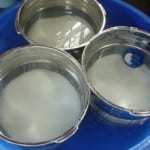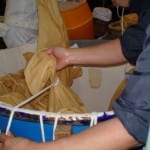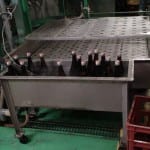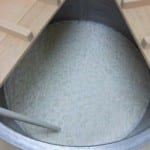 In just about any educational material about sake, we read or hear that the main difference between premium grades of sake like ginjo-shu and regular non-premium sake is the milling of the rice. Specifically, for ginjo sake the rice has been milled much more, and down to a specified degree before brewing. The more the rice is milled, the higher the grade of sake. Short and sweet, and easy to remember. Yeppir.
In just about any educational material about sake, we read or hear that the main difference between premium grades of sake like ginjo-shu and regular non-premium sake is the milling of the rice. Specifically, for ginjo sake the rice has been milled much more, and down to a specified degree before brewing. The more the rice is milled, the higher the grade of sake. Short and sweet, and easy to remember. Yeppir.
While true, beneath the surface of that truth is another, and that is that rice milling is just the tip of the iceberg. In reality, there are a gazillion little things that are done differently in the processes used to make premium sake versus regular sake. At least a gazillion.
Of course, the milling is, in fact, very important. This removes the fat and protein that are found in the outer regions of the rice grains, leaving a higher ratio of starch, and leading to a more refined sake.
But how, beyond the milling, does brewing ginjo differ from brewing regular sake? Basically at every step of the process. Each step is done with increased attention to detail that adds a bit more quality with each successive step, leading to a significantly better sake in the end.
Concretely, what changes? For example…
Once the rice is milled, it is soaked and then washed to remove the clinging rice powder, and to adjust the moisture content. For cheap sake, the rice will be washed and soaked in fairly large vats and lots; that will get almost all the powder off and get the moisture content into the ballpark in a fairly efficient way.
But for ginjo brewing they wash the rice even more thoroughly, and soak in much smaller lots to attain uniformity of moisture across each grain in the batch, and also to get that moisture content to within a half a percent of target. While that was easy to write for me, it is not easy to accomplish. Do not let the significance of that precision be lost on you.
Doing that every single day to a ton or rice at one time takes skill, experience, and attention to detail. In fact, washing and soaking may be the one step where the difference is the most visible to us mortals.
And this lunacy continues with each step. Steamed rice for regular sake goes along a conveyor belt and cold air is blasted through it, but for ginjo, often it is spread out on straw mats to cool down slowly and naturally. The difference in the effort expended is huge. It is almost as if the sake gods conspired to ensure that the more hassle-laden the work is, the better the sake will be.
While less visible, koji-making is where it really gets nuts. Koji, that moldy rice that supplies enzymes for saccharification, as well as much so much flavor-augmenting amino acids, can be made using machines, and/or in huge-ass lots in which the moisture and temperature are not consistent throughout. But for ginjo, koji is often made in trays as small as 1.5 kilos, and then checked every two hours across the 48 or so hours it takes to make. Every. Two. Hours. This helps ensure that every single grain of rice sees the same temperature and humidity, and provides the same enzymatic power.
On to the yeast starter: Ginjo is usually made with different yeast strains, and in yeast-starter rooms that are kept much colder than average to thwart wayward bacteria from proliferating.
Next, fermentation itself. In short, regular sake is fermented in large tanks leading to large yields with large efficiency. Ginjo is always made in smaller tanks, as it is easier to keep the temperature consistent across the whole mash. With a huge tank, the temperature in the center of the mash will not be the same at the bottom, top or sides of the tank. Ginjo tanks will be jacketed too, with coolant running through those jackets at the flip of a sensor-driven switch to help keep temperature appropriately low no matter how warm or cold it is outside.
But wait! There’s more! Once fermentation is complete, the sake is pressed to remove the rice lees. This can be done in a handful of ways, some mundane yet good and some extravagant. You have likely surmised by now that ginjo is made using the much more extravagant, low-yield, hassle laden methods. Even when pressing by machine, a recent trend is to put the whole kit-n-kaboodle inside a refrigerated room to eliminate the activity of bacteria that can damage aromas.
Pasteurization for cheap sake is done roughly and quickly, with stability being the goal. Ginjo is pasteurized in one of a handful of methods each with a handful more variations that try to ensure stability but retain liveliness. Not only is the method important but the timing is paramount as well. For regular sake, such attention to detail is simply not justifiable.
Each one of these adds just a bit to the mix and that incrementally leads to better ginjo. And all of the explanations of each one of the steps above could have been expounded upon ad nauseum to further illustrate the point. But I figured readers have a few better things to read; and you all likely get the point.
Interestingly, all of this has trickled down to once lowly junmai-shu. In other words, the junmai-shu of today is brewed using the ginjo techniques described above, whereas a few decades ago it was more commonly brewed in basically the same way as cheap futsuushu (regular sake). The methods, tools, and attention to detail were the same as very cheap sake; only the milling of the rice and the addition of distilled alcohol were different.
As such, the junmai-shu of just a few decades ago rarely boasted the fine lines of distinction that much of today’s junmai offers. While it was hardly rough stuff, it was not nearly as smooth, genteel, lively or aromatic as the average junmai-shu today – which tends to push the ginjo envelope.
Some less than optimal flavors and aromatics can be particularly pronounced in just-brewed sake; so a bit of maturity – like six months to a year – works wonders in mellowing and melding the various elements. Pasteurization also helps in taking the edge off. As such, the junmai of olde was rarely drunk young, or nama (unpasteurized). It just wasn’t enjoyable enough in that just-pressed state.
But these days, junmai-shu is much more light, aromatic, soft, refined and layered. In fact, of late, the term “fruity” lends itself to many a junmai-shu description. In particular, banana and melon. And much junmai – as well as ginjo – can now be enjoyed very soon after brewing, and as nama too. This evolution is a result of it being made much more like lofty ginjo-shu and daiginjo-shu, and less like plebian futsuu-shu.
Note, though, that not all brewers are making junmai-shu in these ginjo-esque ways. And there are increasingly glaringly obvious differences between the dos and the do-nots. But certainly the basic visible trend is that junmai-shu has approached ginjo-shu and left futsuu-shu behind.
In truth, it is not as clear cut as the above. Not all regular sake is made in the rough ways, and not all ginjo is made using every one of the precision-driven steps above. But in general, the differences are as laid out here.
Both junmai-shu styles and ginjo-shu styles (including daiginjo styles, i.e. “ginjo to die for”) have been evolving for 40 years, and will continue to do so. And that evolution will take place in countless small ways, mostly outside of the milling process. So yes, it is about the milling of the rice, but it is about so much more as well.
~~~~~~~~~~~~~~~~~~~~~~~~~~~~~~~~~~~~~~~~~~~~~~~~~~~~~~~~~~~~~~~~~~~~~~~~~~~~~~~~~~~~~~~~~~~~~~~~~~~~~~~~
Sake Professional Course
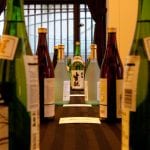 The next Sake Professional Course will be held in Miami, Florida in September.
The next Sake Professional Course will be held in Miami, Florida in September.
The content of this intensive sake course will be identical to that of the Sake Professional Course held each January in Japan. The course is recognized by the Sake Education Council, and those that complete it will be qualified to take the exam for Certified Sake Specialist, which will be offered on the evening of the last day of the course.
You can read Testimonials from past participants here.
If you would like to make a reservation or to be placed on the notification list, please send an email to that purport to sakeguy@gol.com.





